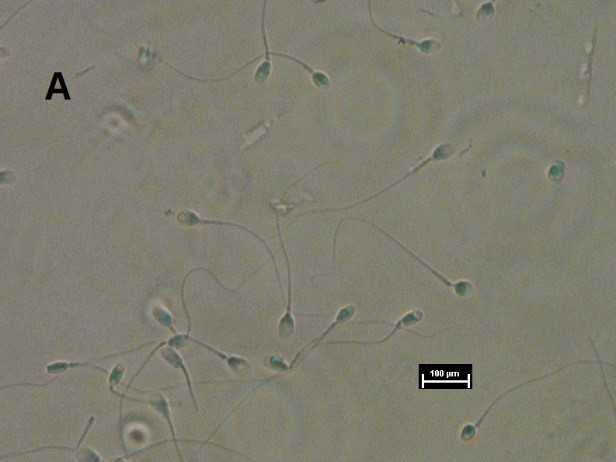Correlations Among Hyaluronan Binding Assay, Annexin-V/Propidium Iodide Staining and Acrosome Reaction for Sperm Quality Assessment
Main Article Content
Abstract
Objective: To evaluate correlation among Hyaluronan Binding Assay (HBA), Annexin-V binding and Acrosome Reaction (AR) with semen analysis by World Health Organization (WHO) criteria.
Material & Methods: Twenty-seven infertile men underwent semen analysis at the infertility center, Naresuan university hospital using basic quantitative method by WHO criteria and qualitative methods by HBA, Annexin-V binding and AR. The results were calculated for correlations among these methods.
Results: The mean age of the study group was 34.2 ± 5.4 years old. The semen analysis showed normal volume, sperm concentration, progressive motility, total motility and morphology. The result of HBA was 87.5%. According to the annexin-V binding assay, most of sperm (80.47%) was viable without apoptosis. The results of Sperm Spontaneous Acrosome Reaction Rate (SARR) and acrosome reaction after ionophore challenge were within normal ranges. There was no correlation between HBA and sperm parameters evaluated by WHO criteria. However, HBA bound significantly correlated with viable sperm and HBA bound negatively correlated with late apoptotic sperm (rs 0.466, p = 0.014 and -0.563, p = 0.002, respectively).
Conclusion: Hyaluronic acid binding assay was correlated with viable sperm and low late apoptosis, but not correlated with sperm acrosome reaction.
Article Details
References
World Health Organization. WHO laboratory manual for the examination and processing of human semen. 5th ed. Geneva: World Health Organization; 2010.
Lefièvre L, Bedu-Addo K, Conner SJ, Machado-Oliveira GS, Chen Y, Kirkman-Brown JC, et al. Counting sperm does not add up anymore: time for a new equation? Reproduction 2007;133:675-84.
Khatun A, Rahman MS, Pang M. Clinical assessment of the male infertility. Obstet Gynecol Sci 2018;61:179-91.
Pandruvada S, Royfman R, Shah TA, Sindhwani P, Dupree JM, Schon S, et al. Lack of trusted diagnostic tools for undetermined male infertility. J Assist Reprod Genet 2021;38:265-76.
Aitken RJ. Sperm function tests and fertility. Int J Androl 2006;29:69-75.
Lewis S, Agbaje I. Sperm DNA tests as useful adjuncts to semen analysis. Syst Biol Reprod Med 2008;54:111-25.
Zini A, Sigman M. Are tests of sperm DNA damage clinically useful? Pros and cons. J Androl 2009;30:219-29.
Oseguera-López I, Ruiz-Díaz S, Ramos-Ibeas P, Pérez-Cerezales S. Novel Techniques of Sperm Selection for Improving IVF and ICSI Outcomes. Front Cell Dev Biol 2019;7:1-23.
Huang C, Lin DP, Tsao H, Cheng T, Liu C, Lee M. Sperm DNA fragmentation negatively correlates with velocity and fertilization rates but might not affect pregnancy rates. Fertil Steril 2005;84:130-40.
Lepine S, McDowell S, Searle LM, Kroon B, Glujovsky D, Yazdani A. Advanced sperm selection techniques for assisted reproduction (Review). Cochrane Database Syst Rev 2019;7:CD010461
Agarwal A, Majzoub A. Baskaran S, Selvam M, Cho CL, Henkel R, et al. Sperm DNA fragmentation: A new guideline for clinicians. World J Mens Health 2020;38:412-71.
Chen Z, Hauser R, Trbovich AM, Shifren JL, Dorer DJ, GodfreyBailey L, et al. The relationship between human semen characteristics and sperm apoptosis: a pilot study. J Androl 2006;27:112-20.
Cross NL, Morales P, Overstreet JW. Two simple methods for detecting acrosome-reacted human sperm. Gamete Res 1986; 15:213-16.
Cummins JM, Pember SM, Jequier AM, Yovich JL, Hartmann PE. A test of the human sperm acrosome reaction following ionophore challenge: relationship to fertility and other seminal parameters. J Androl 1991;12:98-103.
Oehninger S, Franken DR, Sayed E, Barrogo G, Kolm P. Sperm function assays and their predictive value for fertilization outcome in IVF therapy: a meta-analysis. Hum Reprod Update 2000;6:160-8.
Martin G, Sabido O, Durand P and Levy R. Phosphatidylserine externalization in human sperm induced by calcium ionophore A23187: relationship with apoptosis, membrane scrambling and the acrosome reaction. Hum Reprod 2005; 20:3459-68.
Huszar G, Vigue L, Oehninger S. Creatine kinase immunocytochemistry of human sperm-hemizona complexes: selective binding of sperm with mature creatine kinase-staining pattern. Fertil Steril 1994;61:136-42.
Jakab A, Sakkas D, Delpiano E, Cayli S, Kovanci E, Ward D, et al. Intracytoplasmic sperm injection: a novel selection method for sperm with normal frequency of chromosomal aneuploidies. Fertil Steril 2005;84:1665-73.
Beck-Fruchter R, Shalev E, Weiss A. Clinical benefit using sperm hyaluronic acid binding technique in ICSI cycles: a systematic review and meta-analysis. Reprod Biomed Online 2016;32:286-98.
Nijs M, Creemers E, Cox A, Janssen M, Vanheusden E, Van der Elst J, et al. Relationship between hyaluronic acid binding assay and outcome in ART: a pilot study. Andrologia 2010;42:291-6.
Ye H, Huang G, Gao Y, LIU DY. Relationship between human sperm-hyaluronan binding assay and fertilization rate in conventional in vitro fertilization. Hum Reprod 2006;21:1545-50.
Huszar G, Ozenci CC, Cayli S, Zavaczhi Z Hansch E, Vigue L. Hyaluronic acid binding by human sperm indicates cellular maurity, viability, and unreacted acrosomal status. Fertil Steril 2003;79:1616-24.
Hichri R, Amor H, Khammari M, Harzallah M, Fekih FE, Saad A, et al. Apoptotic sperm biomarkers and the correlation between conventional sperm parameters and clinical characteristics. Andrologia 2018;50:e12813.
Li T, Liu W, Xie N, Yang SJ, Zhang C, Fu HL, et al. Value analysis of sperm spontaneous acrosome reaction in male fertility evaluation. Andrology 2017;6:1-5.
Hoogendijk CF, Kruger TF, Bouic PD, Henkel RR. A novel approach for the selection of human sperm using annexin-V binding and flow cytometry. Fertil Steril 2009;91(4):1285-92.
Lee TH, Liu CH, Shih YT, Tsao HM, Huang CC, Chen HH, et al. Magnetic-activated cell sorting for sperm preparation reduces spermatozoa with apoptotic markers and improves the acrosome reaction in couples with unexplained infertility. Hum Reprod 2010;25:839-46.






